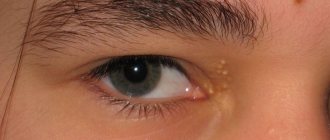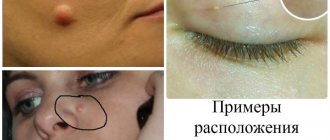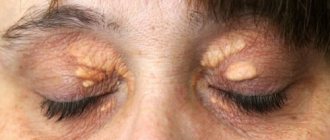Lipoma (fat) is a benign tumor that develops from adipose tissue.
Lipomas are more common in women aged 30 to 50 years. It is localized in the skin, subcutaneous, intermuscular tissue, mammary gland, gastrointestinal tract, lungs, myocardium, meninges, and bones. Patients with single or multiple lumps on the head, face, back and other parts of the body most often turn to the clinic’s specialists.
The equipment of the Miracle Doctor clinic allows you to remove a wen of any size using the following methods:
- erbium laser,
- radio wave knife,
- surgically.
The growth of lipoma is not related to the general condition of the body, because when exhausted, they continue to accumulate fat. Lipoma sometimes reaches large sizes. In these cases, the tumor sags, its base protrudes into a thin stalk of skin, which creates conditions for blood stagnation, swelling and tissue necrosis.
To the touch, a lipoma is mobile, soft and, as a rule, does not cause discomfort to a person unless it begins to grow, squeezing deeper tissues and nerve fibers, causing accompanying symptoms. In addition, the unaesthetic appearance of large wen also makes patients think about removing the lipoma.
Varieties of wen
In medicine, a wen is called a lipoma. This benign formation, which consists of fat cells, affects the surface of the skin. Externally, lipomas are dense tubercles of a yellowish or white hue. Single specimens do not cause concern to humans (except for the aesthetic side). If there are a lot of them on the face, they can cause pain.
Wen can form on the neck, around the eyes, on the chin, near the lips, on the nose, on the ear.
There are many types of lipomas. However, the main ones, most often found on the face, are xanthelasma and milia (millet).
Xanthelasmas are soft, yellowish formations. Their basis is sebum. They can have different sizes and arbitrary shapes. Mostly they pop out on the eyelids. They are mainly concerned about women over 50 years of age. Capable of growing, connecting with neighboring formations.
Milia are small white nodules that protrude above the epidermis. They are formed from horny particles and subcutaneous fat. Can be observed in both adults and infants. In most cases, the skin on the cheeks, chin, and wings of the nose is affected. There are both single and multiple rashes.
They do not cause discomfort and are classified as a cosmetic defect.
Causes of lipomas
The true causes of rashes are not fully understood. They are formed in males and females of different ages.
However, there is an assumption that wen is formed due to the impact on fat metabolism of factors such as:
- High levels of cholesterol in the blood or lipid metabolism problems. Excess cholesterol makes subcutaneous fat more viscous, which leads to blockage of the sebaceous ducts and accumulation of fat in the epidermis.
- Genetic predisposition. In the human body, from birth, uncharacteristic fat cells are formed, which contribute to the further appearance of lipomas. Transmission of the corresponding gene occurs according to the autosomal dominant type.
- Disruptions in the endocrine system. Hormonal imbalances contribute to the accumulation of subcutaneous fat in different parts of the body.
- Kidney and liver diseases. These organs are responsible for hematopoiesis, removal of toxins and excess water. Failures in their activity can lead to the formation of lipomas.
- Aggressive exposure to ultraviolet rays for a long time.
- Menopause, diabetes, gastrointestinal diseases.
- Neglect of personal hygiene rules.
- Bad habits (drinking alcohol, fatty and sweet foods).
People with combination and oily skin types are at risk.
In 50% of cases, a sharp increase in lipomas on the face signals a weakened immune system and the presence of chronic illnesses. Improper facial care, in addition to lipomas, can provoke the formation of acne. This factor accounts for 25% of cases.
How to get rid of wen: advice from a cosmetologist
Dermatocosmetologist Victoria Britko told us what lipomas (lipomas) are, what are the causes of their formation and why they cannot be treated with traditional methods.
Victoria Britko
Dermatocosmetologist
What where When?
Lipoma (fat) is a benign formation with clear boundaries, consisting of fat cells. They can appear on any part of the body: face, arms, back, inner forearm. When pressed, the wen does not hurt. In most cases, they are localized under the skin and do not grow into soft tissue. Wen can appear at any age in both women and men.
Scientists have not yet figured out the nature of these formations. Supposed reasons for their appearance: heredity, vitamin deficiency, lack of protein in the diet, lipid metabolism disorders, bad habits, previous injuries and others.
As research results have shown, lipomas most often begin to form after 40. Although even at 20 no one is immune from them. Subcutaneous wen does not cause any discomfort - it is a cosmetic problem. But their “behavior” needs to be controlled. If the lipoma is actively growing and its size reaches more than 5 cm, you need to consult a doctor. If the diameter is large, it interferes with normal blood circulation in the tissues and must be removed.
How to care for your skin in spring, read the link.
Types of lipomas
Lipofibroma.
A benign tumor consisting primarily of adipose tissue. It grows slowly and does not cause any discomfort.
Fibrolipoma
. This type of wen consists of almost 100% fibrous tissue. Unlike lipofibroma, it feels harder to the touch.
Myolipoma
. Formation consisting of muscle and adipose tissue.
Angiolipoma
. Most often it occurs in men closer to 50 and manifests itself in the form of a node in the extremities. Formed from adipose tissue and may include fragments of blood vessels.
There are also other types of lipomas localized in internal organs and tissues.
Why do lipomas form and how to recognize them?
Most often, wen are formed in cases of impaired lipolysis - the process of destruction of adipose tissue. The triggering factor can be: diabetes mellitus, dysfunction of the thyroid gland, hypofunction of the pituitary gland.
Lipoma is a mobile tumor. It is easily palpable, and the palpation process is not accompanied by pain. The exception is wen, which is localized along the nerve fiber. When pressing on such a lipoma, a person will feel pain.
All fatty tissues have one feature: they do not decrease in size during the process of losing weight. If a lipoma is detected, the patient is prescribed a number of examinations: ultrasound diagnostics, magnetic resonance imaging and others (prescribed by a doctor and selected individually!). If it is necessary to determine the nature of the tumor, a specialist may prescribe a biopsy.
How to get rid of wen?
Forget about traditional methods! At best, they won't work. At worst, they will harm your health. The lymphoma must be removed by a doctor. Today this is done in several ways: surgery, laser, ultrasound. Wen can also be removed using radio wave destruction and radiosurgery.
If there are many lipomas on the body in different parts of the body, only the large ones are removed! First, the patient undergoes tests, receives consultation from an immunologist, endocrinologist, or surgeon, and only after that a treatment program is selected for him.
After removal of the wen, the patient must follow a special diet. He is also advised to take vitamins and lipolytic enzymes.
Read about unusual ways to restore your body here.
Diagnosis and treatment of lipomas
To find out the cause of the formation of wen, it is recommended to consult a specialist.
The therapist collects the necessary information, after which, together with the dermatologist and surgeon, a visual examination of the patient is carried out.
Next, the formations are palpated, and if necessary (suspicion of a malignant nature), a histological examination is prescribed, which involves taking tissue for a biopsy.
Additionally, specialists may recommend ultrasound, MRI, CT, etc. It is important to distinguish lipomas from conditions such as lymphadenitis, hygroma, atheroma, etc. Only after this the doctor determines the tactics for further action.
Treatment methods for lipomas are varied:
- Medication. It involves the use of creams and ointments that help soften the tissues of the epidermis, as well as improve blood circulation. The advantage of this option is that when using local drugs, the likelihood of side effects is minimal. However, it is worth keeping in mind that the result will only be for small-sized wen (no more than 3 cm).
- Surgical intervention. Microsurgery can be performed using either local or general anesthesia. It depends on the location of lipomas. This technique is used in the case of tumors whose size exceeds 3 cm. It is important that after the operation, relapse in this area is excluded.
- Laser. Before the laser procedure, a tissue biopsy must be performed. The removal process is quick. After it there are almost no scars left. In addition, re-growth of wen is excluded.
- Electrocoagulation. Performed under local anesthesia. No regrowth is observed after this procedure.
- Puncture-aspiration method. This option is suitable for combating incompletely formed lipomas, when it is possible to suck out the fat with a needle without damaging the skin. It is painless, but has a significant drawback: there is a high probability of new lipomas forming in place of the removed ones. In addition, the devastated area of skin sags, which does not look very aesthetically pleasing.
- Chemical peeling. The ducts are deeply cleansed of sebaceous plugs. Relapses are excluded.
Is it possible to treat lipoma on your own?
This is not recommended to avoid injuries and various complications. It is also important to consider the following facts:
Lipoma does not go away on its own. If you do not pay due attention to the pathology, it can grow and change, which makes it more dangerous. Treatment of lipoma in the early stages brings the greatest effect.
Removing the lipoma is the only treatment option. Treatment of pathology with conservative methods, including the use of diets and/or physical activity, does not give the desired effect and is fraught with relapses.
In the case of lipoma, surgery is necessary. Do not try to replace it with a course of medications, especially without consulting your doctor.
Modern types of operations to eliminate lipomas do not injure the body and can be performed even on children. Pathology can be treated using laser and radio wave technologies. The technology used affects the cost of the operation. The choice of treatment method is made in consultation with a doctor.
Diagnosis of lipoma
Typically, an experienced professional will diagnose a lipoma during a physical examination. If the lipoma is large or painful, the doctor may prescribe a histological examination or ultrasound to rule out malignancy of the tumor.
Differential diagnosis of lipomas is carried out mainly with malignant tumors; in doubtful cases, cytological examination of punctate and angiography are used.
X-ray diagnosis of soft tissue lipomas is based on the use of long-wave (soft) X-ray radiation.
Prevention
You can reduce the risk of developing wen if you adhere to certain points:
- giving up bad habits;
- maintaining a healthy diet;
- regular hygiene;
- use of exclusively high-quality cosmetics;
- periodic examinations by a dermatologist.
If the precautions still prove to be insufficient and wen forms, you need to seek professional help from a specialist. You cannot pierce or squeeze out lipomas yourself, as this can lead to blood poisoning (due to infection), scars, etc. Only a doctor can determine the nature of the tumor and, if necessary, prescribe treatment.










